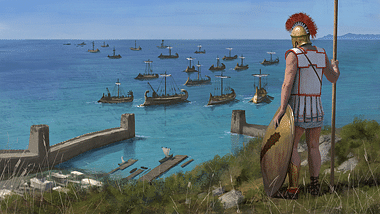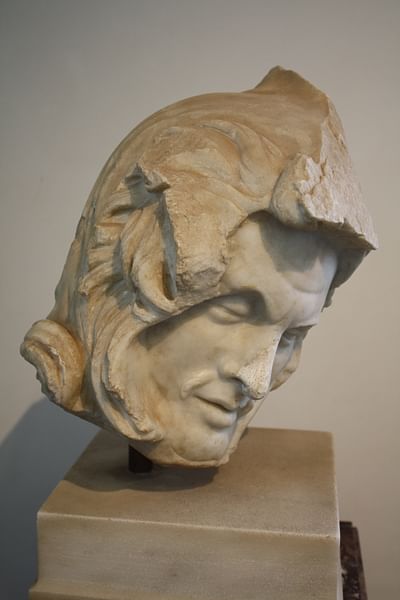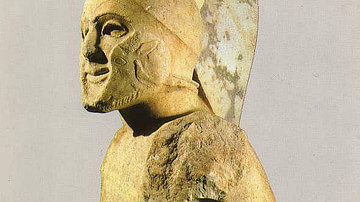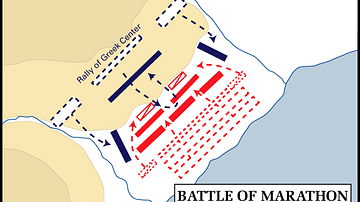
The Persian Wars refers to the conflict between Greece and Persia in the 5th century BCE which involved two invasions by the latter in 490 and 480 BCE. Several of the most famous and significant battles in history were fought during the Wars, these were at Marathon, Thermopylae, Salamis, and Plataea, all of which would become legendary. The Greeks were, ultimately, victorious and their civilization preserved. If they had been defeated then the western world may not have inherited from them such lasting cultural contributions as democracy, classical architecture and sculpture, theatre, and the Olympic Games.
Origins of the Wars
Persia, under the rule of Darius (r. 522-486 BCE), was already expanding into mainland Europe and had subjugated Ionia, Thrace, and Macedonia by the beginning of the 5th century BCE. Next in king Darius' sights were Athens and the rest of Greece. Just why Greece was coveted by Persia is unclear. Wealth and resources seem an unlikely motive; other more plausible suggestions include the need to increase the prestige of the king at home or to quell once and for all a collection of potentially troublesome rebel states on the western border of the empire. The Ionian rebellion, the offering of earth and water in submission to the Persian satrap in 508 BCE, and the attack by Athens and Eretria on the city of Sardis in 499 BCE had not been forgotten either.
Whatever the exact motives, in 491 BCE Darius once again sent envoys to call for the Greeks' submission to Persian rule. The Greeks sent a no-nonsense reply by executing the envoys, and Athens and Sparta promised to form an alliance for the defence of Greece. Darius' response to this diplomatic outrage was to launch a naval force of 600 ships and 25,000 men to attack the Cyclades and Euboea, leaving the Persians just one step away from the rest of Greece.
Marathon
Darius did not lead the invasion of mainland Greece in person but put his general Datis in charge of his cosmopolitan army. Second-in-command was Artaphernes, Darius' nephew, who perhaps led the 2,000-strong Persian cavalry. The total strength of the Persian army was perhaps 90,000 men. The Greeks were led by either Miltiades or Callimachus and they commanded a total force of only between 10,000 and 20,000, probably nearer the lower figure. The long-range assault tactics of the Persian archers was to come up against the heavy infantry of Greek hoplites with their large round shields, spears and swords, and organised in a solid line or phalanx where each man's shield protected both himself and his neighbour in a wall of bronze.
When the two armies clashed on the plain of Marathon in September 490 BCE, the Persian tactic of rapidly firing vast numbers of arrows into the enemy must have been an awesome sight but the lightness of the arrows meant that they were largely ineffective against the bronze-armoured hoplites. At close quarters the Greeks thinned their centre and extended their flanks to envelop the enemy lines. This and their longer spears, heavier swords, better armour, and rigid discipline of the phalanx formation meant that the Greek hoplites won a great victory against the odds. According to tradition 6,400 Persians were dead, for only 192 Greeks. Victory dedications and statues were erected and, for the Greeks, the Battle of Marathon quickly became the stuff of legend. Meanwhile, the Persian fleet fled back to Asia but they would be back, and next time, in even bigger numbers.
Thermopylae
Within a decade, King Xerxes continued his predecessor Darius' vision, and in 480 BCE he gathered a huge invasion force to attack Greece again, this time via the pass at Thermopylae on the east coast. In August 480 BCE a small band of Greeks led by Spartan King Leonidas held the pass for three days but were killed to a man. At the same time, the Greek fleet managed to hold off the Persians at the indecisive naval battle at Artemision. Together, these battles bought Greece time and allowed for its cities to steel themselves for the bigger challenges yet to come.
Salamis
The defeat at Thermopylae, though glorious, allowed the Persians to make in-roads into Greece. Consequently, many states now turned over to the Persians and Athens itself was sacked. In response, a Greek army led by Leonidas' brother Kleombrotos began to build a defensive wall near Corinth but winter halted the land campaign. The next vital engagement was going to be at sea.
In September 480 BCE at Salamis in the Saronic Gulf, the Greeks once more faced a larger enemy force. The exact numbers are much disputed but a figure of 500 Persian ships against a Greek fleet of 300 seems the most likely estimate. The hoplites had won at Marathon, now it was the turn of the trireme to take centre stage, the fast and manoeuvrable Greek warship powered by three banks of oars and armed with a bronze ram. The Persians also had triremes but the Greeks had an ace up their sleeve, the great Athenian general Themistocles. He, with 20 years of experience and the confidence from his leadership at Artemision, employed a bold plan to entice the Persian fleet into the narrow straits of Salamis and hit the enemy fleet so hard it had nowhere to retreat to.
![Greek Trireme [Artist's Impression]](https://www.worldhistory.org/img/r/p/500x600/4650.jpg?v=1737003424)
Themistocles won a great victory and the remaining Persian ships retreated to Asia Minor. The cryptic oracle of Apollo at Delphi had been proved right: 'only a wooden wall will keep you safe' and the wooden triremes of the Greeks had done their job. But still, this was not the end. There would be one more battle, the largest ever yet seen in Greece, and it would decide her fate for centuries to follow.
Plataea
After Salamis Xerxes returned home to his palace at Sousa but he left the gifted general Mardonius in charge of the invasion which was still very much on. The Persian position remained strong despite the naval defeat - they still controlled much of Greece and their large land army was intact. After a series of political negotiations, it became clear that the Persians would not gain victory on land through diplomacy and the two opposing armies met at Plataea in Boeotia in August 479 BCE.
The Greeks fielded the largest hoplite army ever seen which came from some 30 city-states and numbered around 110,000. The Persians possessed a similar number of troops, perhaps slightly more but, again, there are no exact figures agreed upon by scholars. Although cavalry and archers played their part, it was, once again, the superiority of the hoplite and phalanx which won the Greeks the battle. Finally, they had ended Xerxes' ambitions in Greece.
Aftermath
In addition to victory at Plataea, at the roughly contemporary Battle of Mycale in Ionia, the Greek fleet led by Leotychides landed an army which wiped out the Persian garrison there and killed the commander Tigranes. The Ionian states were sworn back into the Hellenic Alliance and the Delian League established to ward off any future Persian attacks. Further, the Chersonnese controlling the Black Sea and Byzantium controlling the Bosphorus were both retaken. Persia would remain a threat with odd skirmishes and battles occurring across the Aegean over the next 30 years but mainland Greece had survived its greatest danger. In c. 449 BCE a peace was finally signed, sometimes referred to as the Peace of Callias, between the two opposing civilizations.
While the Greeks were euphoric in victory, the Persian Empire was not dealt a death blow by its defeat. Indeed, Xerxes' sacking of Athens was probably enough to allow him to present himself as a returning hero but, as with other wars, there are no written records by the Persians and so their view of the conflict can only be speculated. Whatever, the Persian Empire continued to thrive for another 100 years. For Greece, however, the victory not only guaranteed her freedom from foreign rule but also permitted, soon after, an astonishingly rich period of artistic and cultural endeavour which would lay the cultural foundations of all future Western civilizations.








